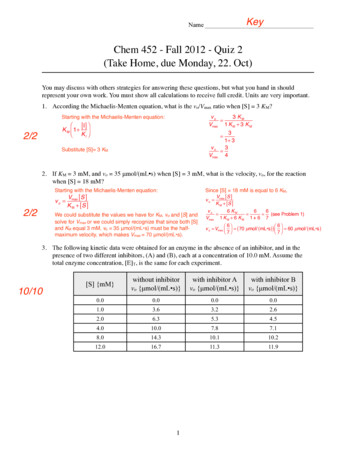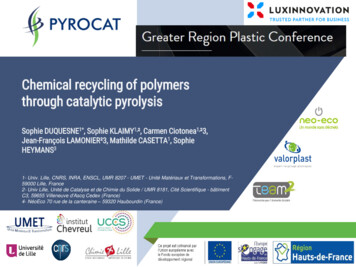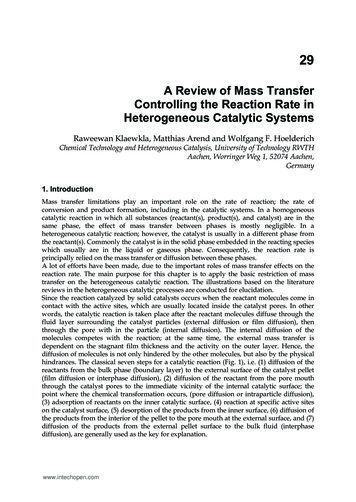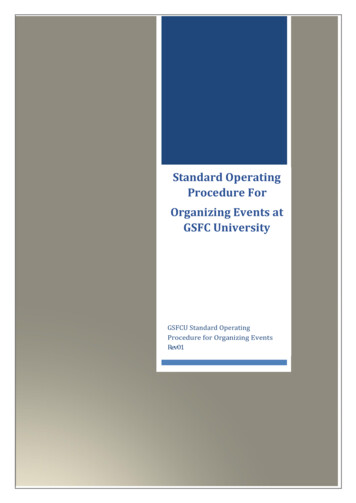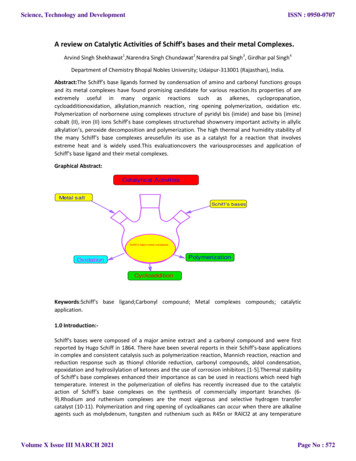
Transcription
Science, Technology and DevelopmentISSN : 0950-0707A review on Catalytic Activities of Schiff’s bases and their metal Complexes.Arvind Singh Shekhawat1,Narendra Singh Chundawat2,Narendra pal Singh3, Girdhar pal Singh4Department of Chemistry Bhopal Nobles University; Udaipur-313001 (Rajasthan), India.Abstract:The Schiff’s base ligands formed by condensation of amino and carbonyl functions groupsand its metal complexes have found promising candidate for various reaction.Its properties of areextremely useful in many organic reactions such as alkenes, cyclopropanation,cycloadditionoxidation, alkylation,mannich reaction, ring opening polymerization, oxidation etc.Polymerization of norbornene using complexes structure of pyridyl bis (imide) and base bis (imine)cobalt (II), iron (II) ions Schiff’s base complexes structurehad shownvery important activity in allylicalkylation’s, peroxide decomposition and polymerization. The high thermal and humidity stability ofthe many Schiff’s base complexes areusefulin its use as a catalyst for a reaction that involvesextreme heat and is widely used.This evaluationcovers the variousprocesses and application ofSchiff’s base ligand and their metal complexes.Graphical Abstract:Catalytical ActivitiesMetal saltSc hif f 's basesSchif f's base metal rds:Schiff’s base ligand;Carbonyl compound; Metal complexes compounds; catalyticapplication.1.0 Introduction:Schiff's bases were composed of a major amine extract and a carbonyl compound and were firstreported by Hugo Schiff in 1864. There have been several reports in their Schiff’s-base applicationsin complex and consistent catalysis such as polymerization reaction, Mannich reaction, reaction andreduction response such as thionyl chloride reduction, carbonyl compounds, aldol condensation,epoxidation and hydrosilylation of ketones and the use of corrosion inhibitors [1-5].Thermal stabilityof Schiff’s base complexes enhanced their importance as can be used in reactions which need hightemperature. Interest in the polymerization of olefins has recently increased due to the catalyticaction of Schiff’s base complexes on the synthesis of commercially important branches (69).Rhodium and ruthenium complexes are the most vigorous and selective hydrogen transfercatalyst (10-11). Polymerization and ring opening of cycloalkanes can occur when there are alkalineagents such as molybdenum, tungsten and ruthenium such as R4Sn or RAlCl2 at any temperatureVolume X Issue III MARCH 2021Page No : 572
Science, Technology and DevelopmentISSN : 0950-0707that can be controlled by the weight of the polymer [12-14]. However, the polymerization ofcycloalkanes at low temperatures stimulated the Schiff’s base, providing control of the polymermolecular weight without reaction (16 - 22). The Metal catalyst based on the Schiff’s baseheterogeneous catalyst has been reported for sustainable resource renewal and the purpose ofreducing greenhouse gases (23-26). An in-depth investigation of the catalyst associated with Schiff’sbase ligand has been reported (27).The Schiff’s base with stereo genic centres are reported, theeffect of this new scheme is similar to that of chirality with bidentate chelating N, P ligand is shownin palladium-catalyzed allylic substitute substitutes (28-35). Schiff's illegal chiral lanthanum (III)properties have shown catalytic activity in asymmetric Diels - Alder reaction and productsproduction and enantioselectivity are influenced by the character of the stimulants. The enantiomercomposition of aziridines and amides made of chiral metalolloporphyrins was limited [36 - 45] butwas developed within the presence of Schiff’s base buildings of Cu (II) and Manganese (III) (4666).These cross-coupling reactions is used as a robust methodology in modern synthetic organicchemistry for the preparation of high-quality ingredients, natural products, liquid , agrochemicals,pharmaceuticals, biologically active compounds, herbicides, UV screens, polymers and hydrocarbons[67-69).The cyclopropanation reactions using Schiff’s base complexes structure as catalysts arereported. The catalysts that are developed for this purpose so far mainly comprise copper(I),rhodium(II)/(III), ruthenium(II) and Co(II)/(III) complexes (70-71). Schiff’s base properties wereincentives that could influence harvesting and selection in chemical conversion; therefore during thisreview, an effort was made to carefully analyse and discuss the role of Schiff’s base complexesstructure in various reactions (72).2.0. General Synthesis of Schiff’s bases.Amine react with aldehyde or ketone to produce Schiff’s base. Many of these methods are under thegeneral acid catalyst. Schiff’s base synthesis is usually taken under the condition of mild or warmacid. Schiff’s base is a product of solid crystals that are basic but some with insoluble salts withstrong acid. Represented by the following equation (73).ORNH2 RRCCR'Primary amineNR H 2OR'Aldehyde/KetoneSchiff basesMechanismRHNORNH2 Primary amineRRCR'Aldehyde/KetoneCOHR'CarbinolamineNRR CH 2OR'ImineFig. 1 General Synthesis of Schiff bases.Volume X Issue III MARCH 2021Page No : 573
Science, Technology and DevelopmentISSN : 0950-0707Where, R' Hor alkyl or aryl3.0. Applications ofSchiff’s basesand their Metal Complexes3.1. Polymerizationreaction:Polymerization reactions was encouraged by various catalysts and was observed in newexperimental numbers. Salen-type Schiff’s base ligand H2L (H2L N, N'-bis (Salicylidine) cyclohexane1, 2-diamine) and Zn (OAc) 2.2H2O excess within Et3N, a new tetra-nuclear structure [Zn4 (L)2 (OAc) 3(OH)] are the most effective forms and a standard standalone detector have been found and havebeen shown to technically regenerate the free ring opening that activates the polymerizationreaction of L-lactides providing similar isotactic poly-l-lactides.Yan et al reported the integration and sequence of unbalanced mononuclear structures of the Salentype Schiff’s base [Cu (Ln)] using the Cu (II) template method in front of one-fifth of 2-hydroxybenzaldehyde, each. These complexes are excellent at reviving metal-complexes polymerization pfMA for the production of syndic-rich poly methyl methacrylate before AIBN, where Copper (II)measurement of the plane structure was closely related to catalytic activity.Lihui et al reported the synthesis and formation of the Zn complex by Schiff’s base [(CH3) 2NCH2CH2N CHC6H3 (OH) (OMe)], synthesis from vanillin and 2-dimethylaminoethylamine [Zn2L2 (OB) 2 andcharacterization by NMR spectroscopy and X-ray crystallography. In addition, the Zn structureinitiated the opening of L-lactide-opening rings and the polymerization modification was wellregulated, causing the polylactide to stop being blocked by OH and benzyl ester groups (74).3.1.1. Ring opening polymerization reaction:Atwood et al reported the synthesis of salen type’s complexes structure. Al (salen) complexesstructure are well prepared by linking chiral or anoral salen ligand with solutions available for trialkylaluminum reagents to the aprotic solvent in RT. Usually, the response is done with toluene. In thisway, the popular alkyl bonding mechanisms of the salen are obtained with excellent yields. Theproperties of XAl (salen), with X Cl, are commonly found and used in the same way usingdialkylaluminium chloride [75]. In this reaction, HCl is usually produced as a product. Therefore,additions are usually made at low temperatures to avoid corrosion of aluminum salen structures; thepresence of blocked groups within the salen support can affect the yield and therefore the previousmelting. In general, structures with fragrant rings replaced by salen ligand are simply separated afterfiltering of the solution. Al (salen) structures are monomeric, with a metal-alkyl or halide reviewelement. It is possible to confirm the structure of a fixed structure by looking at the 1H-NMR signals.Typically, AlMe3 or AlEt3 is used for Al complex integration. Decomposing and non-corrosivepolyesters are important polymers found in a wide range of useful applications [76]. Among all thereported polyesters, polylactide, which is derived from carboxylic acid as a renewable source, hasrecently gained good value due to its biodegradability and biocompatibility. Polylactide is usuallyobtained by opening a lactide ring, which is stimulated by organometallic chemicals. Various metalalkoxide have been proven to be suitable for those polymerization. Among all the employedmaterials, aluminum-based catalysts are effective innovators, due to their ability to regulate polymertechniques through the flexibility of auxiliary ligands [93]. Under this perspective, the use of chiralSalen-type Schiff’s base to treat stereospecificity is important and Al (salen) structures are recruitedwithin the polymerization of lactides. Twinge introduced the synthesis of Salen-type Al complexes toVolume X Issue III MARCH 2021Page No : 574
Science, Technology and DevelopmentISSN : 0950-0707the binaphthyl-imine derivatives method. The locally produced aluminum salen structure wasreported to exhibit significant racial lactide activity in RT (Fig-03) [77].OOAl(salin) complex ,1mol%H3COOOOCH3(PPN)Cl,2eq,propyline oxideH3COOn CH3CH3CH3OFig-03. Reaction of a rac-lactide catalyzed by an Al (salen) complex generated in situDFT studies completed on the catalytic method have been able to confirm that the initiation andpropagation proceeded via an external alkoxide attack on the coordinated monomer.Polylactide alignment has recently been reported for the new structure of trinuclear salen aluminum. In this way, the polymerization of the opening of the cheap lactic ring (rac-LA) occurswith greater work and different considerations.3.1.2. Norbornene Polymerization reaction:Over the past few years, polynorbornene has been widely used in industrial production due toits large physical and chemical properties, including high solubility in daily organic solvents,excellent heat resistance, and its high visibility, three types of norbornene polymerziation (Fig04): (i) Performing Polymerization opening ring. The obtained product still contains doublebonds within the polynorbornene core. (ii) Cationic or strong polymerization. Polynorbornenescomposed in this way always show a low molecular weight [78]. (iii) Vinyl polymerization type.Bicycle bodies remain within the polynorbornene polymer sequence when given this bondingpath.ROMPnCH2nH2Ccationic or radicalH3CCH3Vinyl-polymerizationnH3CCH3nFig 04. Types of polymerization for norbornene.Under the promotion of academic and commercial aspects, certain transition metal structuresare heavily based on various ligands, including bidentate ligands NˆN, NˆO, NˆP and PˆP andtridentate ligands NˆNˆN, NˆNˆO, and -NˆPˆN is currently scheduled for olefin polymerizaNon.Volume X Issue III MARCH 2021Page No : 575
Science, Technology and DevelopmentISSN : 0950-0707Among these metal complexes, nickel-based catalysts are known as oligomerizing ethylene anddimerizing propylene with high R-olefins, and in early 1995 nickel (II) metals were generallyconsidered to be preferred for α-hydride depletion followed by depletion reduction [96].However, transition metal structures with ligands containing asymmetric donor molecules havebeen studied extensively, especially in their use in important parallel processes. In particular,structures containing bidet NˆO ligands have aPracted more aPenNon than ever before.Moreover, according to previous reports, Ni (II) structures with NˆO ligands tend to exhibitappropriate olefin polymerisation action. They are constantly involved in studying the novelintramolecular coated Ni (II) complexes with polymerization activity. Here, a series ofmononuclear nickel (II) structures are formed based on the bis-NˆO-chelate ligand andassembled to perform their polymerization work. These compounds have shown good action tostimulate the polymerization of norborne in the presence of co-catalyst methylluminoxane. Inaddition, the effects affecting catalytic performance are discussed here.3.1.3. Performing Polymerization at Norbornene:The catalyst behavior of this nickel (II) structure has been investigated in accordance with ourprevious work. Preliminary testing of norbornene polymerization was performed prior to MAOas a stimulant (79). They chose MCB as the solvent of the polymerization process because thesolar solvent was able to improve the effect on the polymerization of norbornene vinyl (Fig. 10).The test results are shorter. No catalyst activity found in Complex 1 other than the inclusion ofMAO. In the Complex 1 / MAO catalyst system, the ideal mol / Al / Ni ratio was 2500. Thecatalytic activity and molecular weight (Mw) of the polymer was high prior to Figure 05. Themolecular structure of the molecules of 30% ellipsoids. Hydrogen atoms are not left to chance.The catalytic activity and molecular weight (MW) of the polymer was significantly higher whenthere was a growing MOA. However, catalytic activity decreased slightly as the Al / Ni ratioincreased to 3000. The reaction temperature also affected the performance of the catalyst, with60 C being the simplest method .The reduction in the acquisition function was achieved at ahigh level of 90 C, either due to decay or instability of the active species formed by theprecursor precursors .In Complex 4, the maximum shooting response of up to 3.06 106 g PNBmol - 1 Ni h -1, found in the Aluminum / Nickel molar ratio .This complex has shown highercatalytic activity (approximately twice) than the formation of C and S-chelate nickel (II)structures based on carbon ligand. The catalytic activity of complex 4 is low compared to theNickel complex (II) with N and P-ligand. However, important MAO values should be used inpolymerization, N, P-chelate Ni (II) complex is used as catalyst, and M.W. of polynorbores founddirectly lower (6.47 105 g mol - 1).The results showed that the electronic and stearic effects of different groups affected hardperformance. In general, the structure of the transition metal structure and the electronextraction group associated with ligands often show higher imaginative activity because theelectron extraction group converts the metal center into an electron and connects easily toolefin metal [80]. On the other hand, bulk-grouped groups associated with the structure of themetal process are very helpful in polymerization because larger groups can protect and blockthe nucleus of the metal during the polymerization process. For example, 4 structures with a 4trifluoromethyl group showed better stimulant activity than 1, 2, 3, and 5 .This effect suggeststhat electron effects play a more important role than the stearic effects of these nickel (II)complexes. Increased MAO value. However, catalytic activity decreased slightly when the Al / Niratio was increased to 3000. The reaction temperature also affected the performance of thecatalyst, at 60 C which is the best resolution. Decreased catalytic activity was observed at hightemperatures (90 C), possibly due to decay or instability of active pre-operative species. -1 Nih-1 is reached at 60 C with the appropriate Al / Ni molar ratio. This complex structure definedVolume X Issue III MARCH 2021Page No : 576
Science, Technology and DevelopmentISSN : 0950-0707a participatory function higher (approximately twice) than the C ligand and S-chelate Ni (II)structures based on C-ligand. The catalytic activity of complex 4 is low compared to Ni (II) and Nand P-ligand. However, a significant amount of MAO should be used to make thepolymerization, N, P-chelate nickel (II) complex used as catalyst and M.W. of polynorbores isvery low (6.47 105 g mol - 1) [81].Vinyl-polymerizationnCH3H3CnNi(II) complexesMAOFig-05. Vinyl-polymerization catalyzed by Ni (II) complexes3.1.4. Preparation of N, O Bidentate Ligands.According to previous methods, bidenet ligands HL1-HL5 have been obtained with good yields byreacting between aryl amines associated with 2-hydroxy-1 naphthaldehyde and ethanolsolutions. They are divided into solid yellow when there is a good yield (Fig-06). Spectra dataand analytics of 1H-NMR all verify identity.NH2CHOOHOH 060 c,5hrRNEthanol,Glacial acetic acidRR H,1. 92%4 - OMe 2. 88%4 - CN3. 85%4 - CF 34. 88%2,6 - iPr5. 84%Fig-06. N, O-chelate bidentate ligands3.1.5. N, O-Coordinate Ni (II) Complexes structure 1–5.Similar to the process of forming copper (II) structures [82], Schiff base ligands reaction HL1 HL5 and Ni (II) acetate produced 1-5 N, O-chelate Nickel (II) high yielding properties (Scheme 3).After the reaction has cooled at room temperature the products precipitated from the solution.Complex 1-5 is soluble in toluene and DCM but slightly soluble in petroleum ether. They arestable in the RT atmosphere. Circulation was not observed even after reflux in toluene forseveral hours. The HRMS display of the complex structure showed 1-5 strong peaks (HL1 - HL5).Meanwhile, the formation of TGA has established their thermal stability (Figure 07). However,the discovery of the 1H and 13C-NMR fractures of these structures has not been reported dueVolume X Issue III MARCH 2021Page No : 577
Science, Technology and DevelopmentISSN : 0950-0707to the para-magnetism of the Ni (II) structures. The IR spectra of the N structure, O-chelatenickel (II) is the same. A common feature of these complexes is that C N increases vibration ofthe ligands (1625-1635 cm - 1) which are converted to lower frequency.RNROHoNO60 C, 5 h,MethanolNi (CH3OO) 2Ni . 4H2ONOR H 1. 80%4 -OMe 2. 78%HL 1 -HL 5R4 -CN 3. 82%4 - CF 3 4. 85%Complex 1-52,6 - iPr 5. 79%Fig-07. N, O-coordinate Ni (II) Complexes 1–53.2. Alkenes reaction:-The catalysis of styrene oxidation with molten metals is of particular interest in both biomimetic andsynthetic chemistry. In their research, Schiff’s base properties have been studied for their potentialuse in response to the oxidation reaction of styrene and cyclohexene. Not only is this oxidationreaction but also in many forms, an important role is eco-friendly with easily available oxidants likeH2O2 and air. It is also important that the catalysts are physically stable enough to achieve thesetypes of responses that usually require high temperatures [83]. In addition their catalytic activities,Schiff’s base have also been studied for their biological functions in previous studies .They havedescribed here the complete synthesis, appearance and heat of carbazole obtained by Schiff’s baseligand and their [CoL (H2O) 2]2AcO (and [Mn (H2O) 2]2AcO (II) effect of them as stimulants in theoxidation response of cyclohexene and styrene [84].OCH2CHO 1 molcatalyst,H 2 O 2Styrene oxideStyreneBenzaldehydeO1 molcatalyst,H 2 O 2O -CyclohexaneCyclohexane oxide2 CyclohexanoneFig-08 Oxidation of Styrene and cyclohexaneVolume X Issue III MARCH 2021Page No : 578
Science, Technology and DevelopmentISSN : 0950-07073.2.1.Cyclopropanation of olefinsThe Stoichiometric condensation reaction of Co (II) porphyrin complexes with ethyl diazoacetateswas now disclosed in 1975 by Johnson et al. A recent years have witnessed significant impact of Co(II) porphyrins to the cyclopropanation of olefins with azo reagents. The ESI-MS, EPR as well as DFTstudies exposed that the Co(II)-porphyrin-mediated cyclopropanation of olefins with diazoestersproceeds via the Formation of Fisher-type radical carbine II, followed by stepwise radical addition ofolefins (1) and cyclization cascade toward the same cyclopropanes 3 and 4 (Fig-09). “toxic radicalcarbene types” II and the “connecting carbene species is planned to be with III redox isomers andwith each vibrant equilibrium, Others, however the latter decided to be somewhatthermodynamically more stable according to DFT calculations. The dynamic equilibrium betweenspecies II and III is expected to prevent the formation of dimerization by-products (such as- diethylfumarate and DEM in case of EDA) during olefin cyclopropanation. The existence of the radicalcarbene molecule bound to d6 Co (III) nucleus of the species II accounts for its more nucleophiliccharacter, i.e. an unusual radical reaction to carbines bound to other metallic porphyrin complexes.The nucleophilic part of the carbene radicals II permits cobalt (II) porphyrins to catalysecyclopropanation of e- deficient olefins such as methyl acrylate. Zhang and co-workers developedD2-symmetric chiral porphyrin ligands bearing secondary amide functionality and their Co (II)complexes as cyclopropanation catalysts. Co (II) porphyrins with amide functionality showed higherreactivities, diastereo and enantioselectivities than those without amide functionality such as cobalt(II) tetraphenylporphyrin. This observation was attributed to the creation of an H- bond among thecarbonyl O2 of the carbene moiety and the N-H hydrogen of the amide functionality.R*H3CR* H3CNR*5: M 2HN6: M CoMNH3CCH3R*N7: M 2H8: M CoR*R* H3CFig 09. Co (II) porphyrin complexes 6 [Co (TMP)] and 8 [Co (por*)] (left). The shape of Co (por*)They revisited the catalytic cyclopropanation of styrene in the presence of 6 with EDA (2a) andt-BDA (2b). Co (TMP) (6) was chosen as the model complex to find out the optimum reactionconditions because of its very close similarity to the Co (por*) in terms of its steric andelectronic features as well as considering its ready availability. A dynamic reaction between1Aand 2A in toluene at room temperature was observed when 2 mol% of 6 was employed .After20 minutes the conversion was almost quantitative. Then, the quantity of 6 was reduced on 1.5mol%, 1 mol%, and 0.5 mol%, consecutively.Volume X Issue III MARCH 2021Page No : 579
Science, Technology and DevelopmentISSN : 0950-0707Under these conditions, smooth the reaction between 1A and 2A also easily took place, givingthe same diastereomeric ratio (Cis /Trans,) 30:70. But, 1 mol% of the Co (TMP) amount wasdetermined to be precise with favour to the reaction time. When the solvent was changed toTHF, the reaction took more than one day, and did not go to completion even at 60 C. Co (III)tetramesitylporphyrin bromide Co III (TMP) Br) that was produced in situ by giving 6 with Br2(0.5 equiv. With respect to 6) before adding styrene and EDA to the reaction mixture have beentested as potential catalyst for cyclopropanation of styrene (1A) with EDA (2A). However, noconversion was detected in this case, t-BDA (2B) was then used as carbene source. The reactionmixture of styrene (1A) and t-BDA (2B) had to be heated up to 80 C affording the correspondingcyclopropanes products 3b and 4b in reasonable yield (85%) under the same situations.Changing the diazo ester from EDA to tBDA afforded higher diastereoselectivity, 70:30 vs. 10:90(cis: trans) ratio, respectively, as expected. The effect of co-ligands was also investigatedexpecting to observe any coligand acceleration in the cyclopropanation of styrene (1A) with tBDA (2B) because of the somewhat slower reaction between 1a and 2b. For this purpose, 4(dimethyl amino) pyridine (DMAP) and Nmethyl imidazole (NMI) were tested as coordinating coligand. However, in difference to our expectations, an inhibition in the presence of NMI and adeceleration in the presence of DMAP of were observed. Later these displays, the idealconditions for the cyclopropanation of styrene were determined by using EDA and tBDA.Cyclopropanation of 1, 2-dihydronaphthalene and 1-octene was also used, by using 1 mol%6and EDA in toluene. However, no conversion was noticed in both cases. These “adverse” resultsare in line with the reactivity profiles for cobalt porphyrin-based radical carbenes incyclopropanation observed previously: There has been no report on the cyclopropanation ofaliphatic olefins and 1, 2-dihydronaphthalene with EDA or t-BDA, in the occurrence of Co (II)porphyrins. Chiral co-porphyrin for catalytic asymmetric cyclopropanation Yet, Zhang et al.That 1-hexane can be cycled at moderate yields (43%) with the common carbine sourceitnitrodiazoacetates.Using co (II) porphyrin in the cyclopropanation [85-86]. On the other hand,it can be likely to be a steric factors can avoid the cyclopropanation of 1, 2-dihydronaphthalene.It should be noted that no dimerization by-products like fumarate or maleate esters weredetected during cyclopropanation of styrene with EDA and t-BDA.PhCH2 Co(TMP) (6)N2CO 2RSolvent Additive Ar1a2a: R Et2b:R tBuCO 2R PhPhCO 2R3a: R Et4a: R Et3b:R tBu4b:R tBuFig-10. Cyclopropanation of styrene (1A) catalyzed by diazo esters 2A and 2B catalyzed by Co(TMP) (6).aVolume X Issue III MARCH 2021Page No : 580
Science, Technology and DevelopmentISSN : 0950-07073.3.Cycloaddition reaction:3.3.1. Catalytic cycloaddition of CO2 to epoxides: Hydrazone-related compounds associated with ONO pincer type co (III) were subsequently isolatedas a result of cycloaddition of CO2 to epoxides under non-solvent conditions. All responseparameters, including pressure, temperature, mole and time were set for the use of the substrate ofthe version with co-catalyst externally and externally. The precursors used in the compounding of Coproperties included as Co (CH3COO) 2 salts and therefore free ligands were tested for their detectionof its ability to trap CO2 cycloaddition into epichlorohydrin to form cyclic carbonates [108]. No cycliccarbonate is available, due to the well-known fact of a higher reaction mechanism, a higher reactionmechanism. Subsequently, the catalytic hobby of these complexes was examined to further optimizethe result of various reaction parameters. No yield was obtained for RT and the lowest conversionwas observed at 50 C (Table 3, incl. 1, 2) with no change in the long reaction time of 24 h.Insufficient conversion was observed at 75 C at 2 Kg / cm2 of CO2, which raises the effect of heat onthe catalyst implementation. The highest yields were obtained at 100 C and an impressive yield at120 C at 2 Kg/cm2 from 6 to 24 h. A major failure to use CO2, as a reagent in biological modificationis that the risk involved is associated with high blood pressure [87-88].OOClReaction time -3 hr1.OODMAP (0.1 mol%)H3C2.OOReaction time -8 hrH3CODMAP (0.1 mol%)OOOHOOOReaction time 16hr3.DMAP (0.1 mol%)OOReaction time 20hrO4.H3CDMAP (0.1 mol%)H3COFig-11 Addition of CO2 to several tested epoxidesConsequently, they were happy to see that their catalyst was operating at 2Kg / cm2 coffee pressurewithout co-operation. Although a good yield is employed at 120 C and 2Kg / cm2 without cocatalyst, we would develop very simple systems that apply to high pressure. Therefore, weinvestigated all three compounds in different hydrazide chains with special co-catalysts includingtetra-n-butyl ammonium bromide (TBAB), tetra-n-butyl ammonium chloride (TBAC), tetra-n-butylammonium iodide (TBAI), as well as dimethylaminopyridine using a pressure of 1 bar . It is clear thatcatalyst 2a combined with DMAP as a co-catalyst has shown excellent efficacy between these threeindividuals. They accept it as true and this is possible because of the proper linking area found withinthe complex. The comparative low variables are considered for complex 2b and 2c. Unsurprisingly,TBAB authenticity is a contributing factor to carbon dioxide cycloaddition reactivation in the bestcases reported once and For all transition metal complexes structures, low yields are obtained byTBAB and TBAI. In contrast, TBAC and DMAP were rated as the best co-catalysts with almost 99%conversion with 99% selection. Based on the TBAC status, we have selected complex 2a and DMAPVolume X Issue III MARCH 2021Page No : 581
Science, Technology and DevelopmentISSN : 0950-0707as a co-catalyst at 120 C and 2.0 Kg / cm2 because of the improved state of CO2 cycloaddition onepoxides [89-90]. To date, many systems involved in several metal processes, particularly the cobaltstructures reported within the cyclic organic carbonates synthesis, use much more loading.Therefore, they examined the effect of catalyst charging on CO2 synthesis with epichlorohydrin. Theywere delighted to find the simplest TON of 200,000 among all the reported cobalt and other metalstructures to combine CO2 and epoxides at a pressure of 1 kg / cm2 which is even the simplest TONreported using this pressure. Finally, a catalytic system was developed to match the prevalence ofother epoxides that provide the same cyclic carbonate with limited yields and 99% selectivity.Excellent conversion has been achieved with aliphatic and aromatic epoxides. One of the hopefulresults of the above scheme is that a major overhaul and consequently the formation of in-catalystwithin the reaction process. Recycle of catalyst, is very important.3.4. Oxidation reactionSchiff’s base Co (II) complexes catalysts have been shown to bind dioxygen more or less backwardand are therefore frequently studied as a classical chemical that carries oxygen carrier and its use inO2 storage, and as a biological compound due to structural properties. Their catalytic propertiesunder slight conditions. Co (II) with four tridentate, has been shown to be an effective stimulant ofoxidation of Styrene, benzyl alcohol and cyclohexane. The use of tert-butyl hydro peroxide andperoxide as an oxidant in a similar reaction. Also described are the analytical functions of Schiff’sbase Co (II) structures that undergo the hydrolysis of aminoalkanoic acid and esters. The complexoxidative properties of Ru (III) have been studied with the oxidation of cycloxexanol and benzylalcohol through air, H2O2, O2 as the oxidant of these compounds that have been used to stimulatealcohol oxidation in the carbonyl compound. , Priyarega et al. (91). This work demonstrates that thestructures have become a catalyst for the transfer of catalysts (Fig- 12) for oxidation of cyclohexaneand toluene within H2O2 because they are oxidant under slight conditions. There, cyclohexane isoxidized to produce cyclohexanol and cyclohexanone and adipic acid (92).O
2.0. General Synthesis of Schiff's bases. Amine react with aldehyde or ketone to produce Schiff's base. Many of these methods are under the general acid catalyst. Schiff's base synthesis is usually taken under the condition of mild or warm acid. Schiff's base is a product of solid crystals that are basic but some with insoluble salts with
